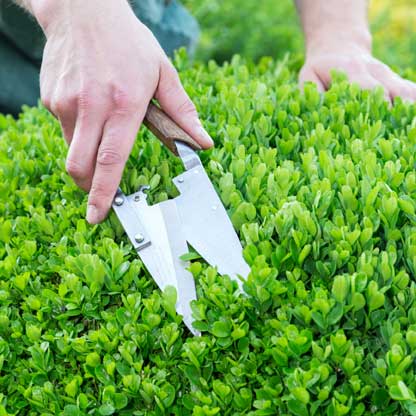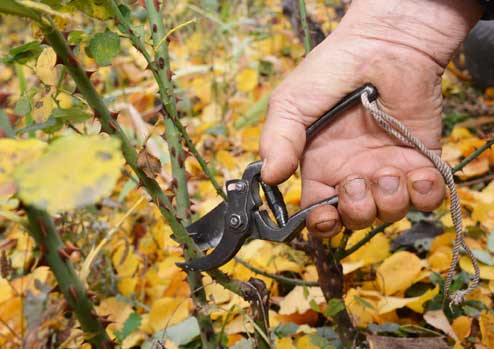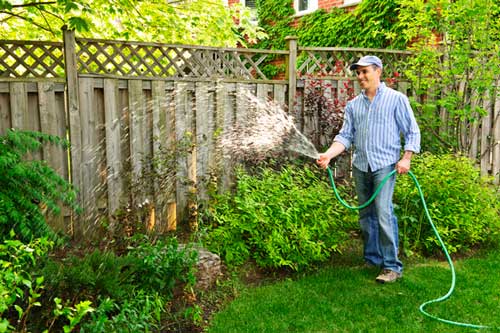Maintenance
The Importance of Proper Maintenance
The third pillar of our triumvirate covers the follow-up and on-going care plants require to become established and thrive. Once a plant is in the ground and mulched, the name of the game is WATERING. While it is true that more plants succumb to over-watering, the initial stage of acclimating can require close attention to watering; a little extra water can be a good thing, at least in the beginning.
It is far better to water deeply at longer intervals than shallow watering daily or randomly. Deeper watering helps the soil to settle (we do not follow the old notion of filling the planting hole halfway and flooding it to settle the soil before back filling the hole to the top (this can cause a layer of mud that gets compacted, drowning roots and destabilizing the root ball os larger plants/trees). Nor do we tamp down the soil once the hole is full; I much prefer to allow the soil to settle naturally with watering which can fill any voids in the planting medium. When a new plant looks wilted, always double check the moisture level of the soil AND the root ball; if the roots were compacted/ required scoring, they may be traumatized and show signs of stress. In this case, it may be better to shower the crown to cool and hydrate the foliage, rather than over-watering the roots. Hydrangeas are a classic example of the behavior.
Deep watering draws roots deeper in the soil instead of forming a mat on the surface which can get stressed and die back, allowing rot to penetrate. Poor planting and over-mulching create a 'perfect storm' for crown rot.
Pruning is as important as watering once plants are established.
When and how to prune has filled many books, so suffice it to say knowing your plants, selecting the proper varieties to minimize pruning will reduce your workload and expense. One fact many people do not recognize is that pruning wounds the plant. Once done, the plant responds by activating new growth to compensate for that wound.
New research has shown that limiting the amount of pruning reduces the need for follow up pruning. We deal with a lot of mature gardens where many different types of plants (Hollies, Azaleas, Boxwood for examples) have all been treated the same way: sheared into round blobs without any individual character. The result: The Green Shell. All the growth is confined to the outer layer, leaving the interior full of dead branches with little regeneration and inhibiting light and air penetration. This is generally the result of a dependence on power tools to prune, leaving many cut leaves and shattered branches.
 We pride ourselves on mastering the art of Regenerative Pruning. We prune inside the Shell to remove deadwood and thin out the Shell at different levels to encourage new growth. This skill requires training, patience and time; while it is not the cheapest or fastest approach to regulating plant size, the results are long-lasting and plant vigor can be restored. Sometimes poor selection precludes this approach and plant removal and replacement with a more appropriate variety is required; but that becomes an opportunity to recondition the soil, correct drainage and install a much better candidate.
We pride ourselves on mastering the art of Regenerative Pruning. We prune inside the Shell to remove deadwood and thin out the Shell at different levels to encourage new growth. This skill requires training, patience and time; while it is not the cheapest or fastest approach to regulating plant size, the results are long-lasting and plant vigor can be restored. Sometimes poor selection precludes this approach and plant removal and replacement with a more appropriate variety is required; but that becomes an opportunity to recondition the soil, correct drainage and install a much better candidate.
Pruning brings us up close and personal with our plants and affords an excellent opportunity to seek out and destroy WEEDS. Following our pruning program enables us to roust out vines and other weeds inside plants before they take hold and impact plant vigor. Too many times we have approached a declining shrub only to discover there is more weed/vine volume inside the Green Shell than shrub!
My personal favorite form of pruning is dead heading; removing spent flowers to promote fresh growth and inducing more flowering. Application of dead heading can extend the flowering season of many perennials, annuals and woody plants.
Surprising how many people are intimidated by facing off with a shaggy shrub or Rose and cannot decide where to start and how far to go. As with so many things in Life, experience/practice makes all the difference: I can reach my Zen State elbow-deep in a Rose thicket visualizing the underlying structure that will rejuvenate a geriatric focal point in a mature estate garden. This is what I have cultivated for the past four decades and want to pass on to my successors.
